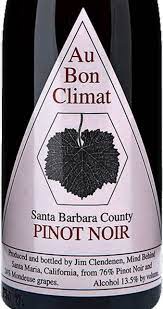Copain’s P2 is a red 50/50 blend of Pinot Noir/Pinot Gris from Sonoma.
Au Bon Climat’s Santa Barbara County Pinot Noir is actually a 76/24 blend of Pinot Noir/Mondeuse.
Ojai’s Red Table wine, when they make it, is a blend of whatever they’re making that year, mostly Syrah and Pinot Noir.
J Mourat’s Collection Rouge is a kitchen sink blend of Loire reds, usually Pinot Noir and Cab Franc with others mixed in.
I’m not saying that it can’t make a ‘tasty’ wine - but generally when pinot is blended with other stuff, the ‘pinot-like’ qualities get diminished . . .
Really? That’s quite shocking if true. Their SBC pinot when I’ve had it tends towards the light bodied, red fruited end of the spectrum, I can’t really imagine it’s 24% mondeuse (or any amount mondeuse).

It’s been a while since I’ve bought one, but I’ve definitely seen this label with the variety split.
What vintage is that? The 2022 current release does not include Mondeuse at all. I’m wondering if they did that in a ‘challenging’ year where pinot was not as readily available OR if they were trying to stretch the blend that year.
Cheers
I think the 2006 was 22% Mondeuse, so must have done it at least a couple of years. Would also be surprised if it were a regular thing, though.
-Al
Why? I’ve understood Mondeuse is lighter than Pinot Noir. Stylistically it can range from tart red berries to crunchy dark berries, depending on the terroir and style. And IIRC, normally it’s hard to get Mondeuse above 12% ABV without chaptalisation. Definitely a useful variety if one wants to add freshness, acidity and push alcohol down.
Although I haven’t had any Californian Mondeuse. Maybe it’s just a different thing there. Or turns out to be a different variety altogether. ![]()
I had an old NV Simi Pinot (4/5 pint bottle) that was clearly a large percentage PS. There was Pinot character in there, but it was pretty simple and monolithic. I think that’s the sort of wine that made people think no one figured out how to make Pinot here back then…while others from the same era could pass for good Burgs. A decade or so ago I had a Pinot where the winemaker was proud about the 1.5% PS he added to his Pinot. You could taste it, feel the structure, etc. It’s just not understanding and respecting the grape, and trying to force it into being something else.
Meanwhile, the Harrington Trousseau-Pinot Al mentioned was successful, imo. The Pinot character and its site (Coast Grade) were clear. The problem was it was a blend of $30 and $45 wine that had to sell for $30. He followed that up with a lesser Pinot site the next year, and that was a “why bother doing this again” wine.
The 50/50 Waxwing I mentioned on the other thread was a declassified barrel each from a great Bennett Valley Syrah site and a great SCM Pinot site (Lester iirc). Something lacking in each, so they weren’t included in the regular wines. An intuitive experiment with those leftovers showed they filled each others weaknesses, complimented each other. Both varieties and sites showed clearly. But, you wouldn’t do that on purpose, because that was two (then) $45 components to make a $20 wine. The happenstance was it was a $20 wine that, to me, was on par with the two SVDs, made with declassified juice.
If you want an out-of-the-box suggestion, 3 Fontainen make a druif spätburguner (cofermented juice and lambic) that is really tasty.
Two I used to import:
Marie-Therese Chappaz “Dole” from the Vallais. IIRC 90% PN and 10% Gamay. One of here more simple, entry level wines. Pleasant, easy to drink.
Domaine Miolanne “Volcane Rouge” from the Auvergne. 50/50 PN/Gamay. A nice poor man’s Pinot Noir. No real complexity but a fun, enjoyable drink that hints at what PN can be without dropping too much cash.
“Dôle” is s traditional Pinot Noir/Gamay blend fom the “Valais AOC” in Switzerland:
“Dôle is a light-hearted Valais wine that is the offspring of the two most widely planted red grapes in Valais, Pinot Noir and Gamay.”
Not uncommon in Jura. Domaine du Pelican’s Trois Cepages (PN, Trousseau and Poulsard) is a lovely example.
